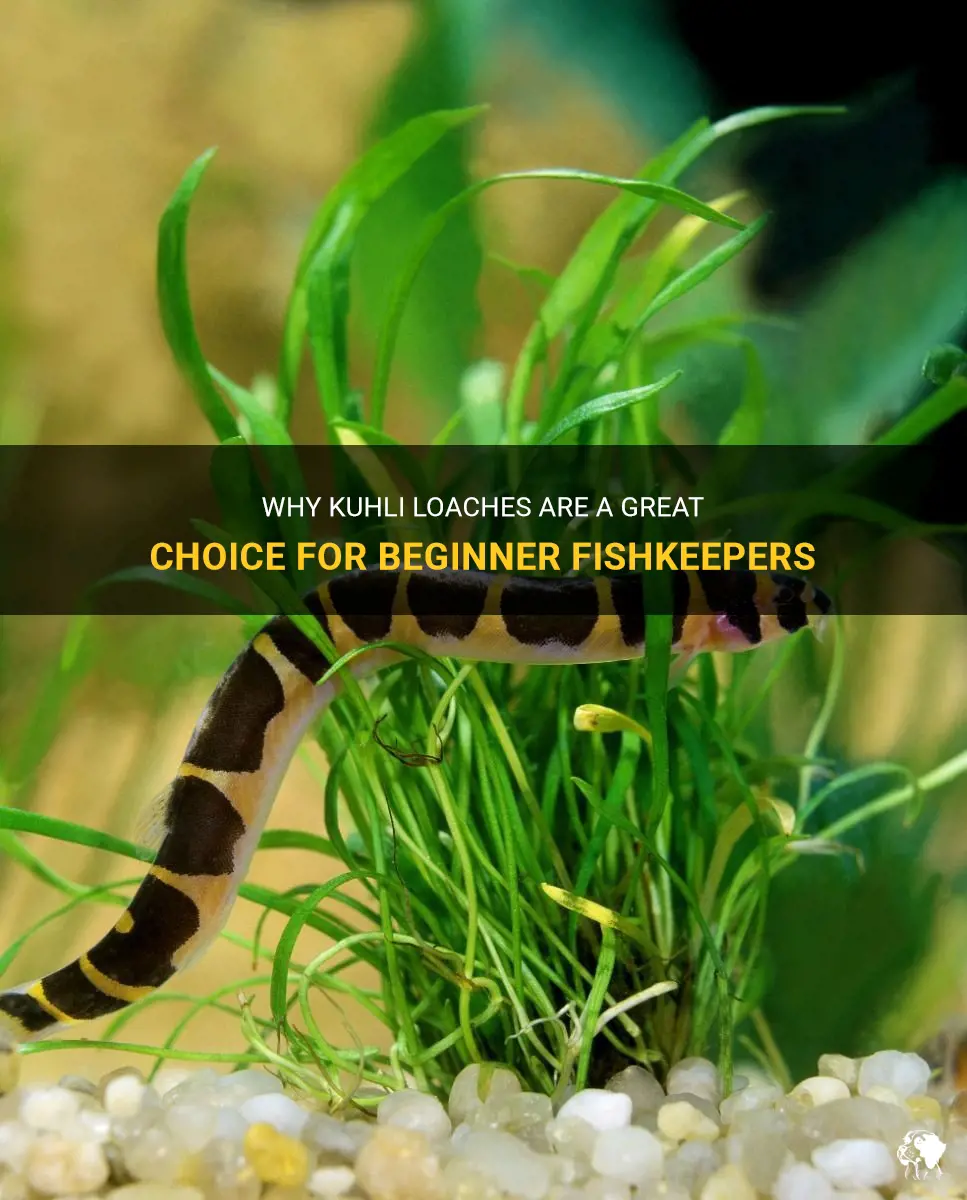
If you're new to the world of aquarium ownership and looking for a unique and fascinating fish to add to your tank, the kuhli loach might just be the perfect choice. These small, eel-like creatures are not only visually stunning with their striped patterns and sleek bodies, but they also have a peaceful temperament and are relatively low-maintenance. Whether you're a beginner or an experienced fish keeper, the kuhli loach can bring an exciting and captivating element to your aquarium.
| Characteristics | Value |
|---|---|
| Temperament | Peaceful |
| Difficulty Level | Easy |
| Size | Small |
| Lifespan | 5-8 years |
| Tank Size | Minimum 20 gallons |
| Water Conditions | pH 6.0-7.5, temperature 75-82°F |
| Diet | Omnivorous |
| Behavior | Nocturnal, hides during the day |
| Compatibility | Peaceful community fish |
| Maintenance Level | Low |
| Tank Setup | Plenty of hiding places and soft substrate |
| Breeding | Difficult |
| Growth Rate | Slow |
| Disease Prone | Generally hardy with proper care |
What You'll Learn
- What is a kuhli loach and why are they commonly recommended for beginners?
- What are the main care requirements for kuhli loaches?
- How do kuhli loaches behave in a community tank with other fish?
- Are kuhli loaches difficult to feed and what type of food do they require?
- What are some potential challenges or problems that beginners may encounter when keeping kuhli loaches?

What is a kuhli loach and why are they commonly recommended for beginners?
Kuhli loaches are a popular choice for beginner fishkeepers due to their unique appearance, peaceful nature, and relatively low maintenance requirements. These small, eel-like fish are native to Southeast Asia and are often found in slow-moving rivers and streams. In this article, we will explore what makes kuhli loaches a great choice for beginners and how to provide the best care for these fascinating little fish.
One of the main reasons kuhli loaches are commonly recommended for beginners is their peaceful temperament. They are generally non-aggressive and get along well with other community fish species. This makes them an excellent choice for community tanks, where various fish species coexist. They rarely exhibit any aggressive behavior towards their tankmates, which helps create a harmonious environment in the aquarium.
Kuhli loaches also have a unique appearance that sets them apart from other fish species. They are elongated and have a slender, snake-like body. Their skin is covered in small, scaleless, and smooth patterns, which can come in a variety of colors including brown, black, and yellow. Additionally, their small size, typically reaching only 3-4 inches in length, makes them suitable for smaller aquariums and tanks.
When it comes to care requirements, kuhli loaches are relatively easy to maintain. They are omnivorous and will readily accept a variety of foods, including flakes, pellets, freeze-dried or frozen foods, and live foods. It is important to provide a varied diet to ensure they receive the necessary nutrients. High-quality sinking pellets or wafers can form the staple diet. Additionally, supplementing their diet with occasional live or frozen foods like bloodworms or brine shrimp is recommended.
Kuhli loaches are also hardy fish that can tolerate a range of water conditions. They prefer soft, slightly acidic water with a pH between 6.0 and 7.0, and a temperature ranging from 75°F to 82°F. However, they can adapt to a wide range of conditions, making them tolerant of beginner mistakes. It is still important to regularly test water parameters and perform water changes to ensure optimal health.
To create a suitable habitat for kuhli loaches, it is recommended to provide them with plenty of hiding places. This can be achieved by adding driftwood, rocks, and plants to the aquarium. The addition of fine substrate, such as sand or small gravel, is also beneficial as kuhli loaches love to burrow and sift through the substrate. A well-planted aquarium with low to moderate lighting will provide a natural environment for them to thrive in.
In conclusion, kuhli loaches are a great choice for beginner fishkeepers due to their peaceful temperament, unique appearance, and relatively low maintenance requirements. Their ability to coexist with other fish species and adapt to a wide range of water conditions makes them a popular choice for community tanks. By providing a varied diet, suitable habitat, and maintaining proper water parameters, beginners can enjoy the beauty and charm of these fascinating little fish.
The Best Foods to Feed Kuhli Loaches for Optimal Health and Growth
You may want to see also

What are the main care requirements for kuhli loaches?
Kuhli loaches, also known as pangio kuhlii, are small eel-like fish that can make great additions to aquariums. They are known for their unique appearance and peaceful demeanor, making them a popular choice for fish enthusiasts. However, like any fish, they have specific care requirements that need to be met in order for them to thrive in a captive environment. In this article, we will discuss the main care requirements for kuhli loaches.
Tank Size and Setup:
Kuhli loaches are relatively small fish, with adults typically reaching a length of 3-4 inches. However, they are active and social creatures, so it's important to provide them with enough space to swim and explore. A minimum tank size of 20 gallons is recommended for a small group of kuhli loaches. The tank should be set up with plenty of hiding spots and vegetation, as these fish enjoy burrowing and hiding during the day. It's also important to provide a sandy substrate, as kuhli loaches like to bury themselves in the substrate for protection.
Water Parameters:
Kuhli loaches are native to Southeast Asia, where they inhabit slow-moving streams and rivers. Therefore, they prefer soft, slightly acidic water conditions. The ideal water temperature for kuhli loaches is between 75-82°F (24-28°C), and the pH should be kept between 6.0-7.5. It's important to regularly monitor the water parameters and perform regular water changes to ensure optimal water quality.
Tank Mates:
Kuhli loaches are peaceful fish that can coexist with a variety of tank mates. However, they are relatively shy and can be easily outcompeted for food, so it's best to keep them in a community tank with peaceful, non-aggressive species. Avoid keeping them with larger, more aggressive fish that may see them as prey. Good tank mates for kuhli loaches include small tetras, guppies, and other peaceful bottom-dwelling fish.
Feeding:
Kuhli loaches are primarily scavengers and will eat a variety of foods in the wild. In the aquarium, they should be fed a varied diet consisting of high-quality sinking pellets, frozen or live foods such as bloodworms or brine shrimp, and occasional vegetable matter. It's important to feed them in the evening or at night, as they are nocturnal feeders. Be mindful not to overfeed, as kuhli loaches are prone to obesity.
Behavior and Socialization:
Kuhli loaches are social fish that thrive in groups. It is recommended to keep them in groups of at least 5-6 individuals, as this will provide them with a sense of security and reduce stress. They are relatively peaceful and can be kept with other bottom-dwelling species. Kuhli loaches are known for their burrowing behavior, so it's important to provide them with plenty of hiding spots and caves in the aquarium.
In conclusion, kuhli loaches are unique and interesting fish that can make great additions to a well-maintained aquarium. By providing them with a suitable tank setup, proper water parameters, compatible tank mates, a varied diet, and a social environment, you can ensure that your kuhli loaches thrive and display their natural behaviors. Always remember to research and understand the specific care requirements of any fish species before adding them to your aquarium.
The Fascinating World of Loach Fish: Everything You Need to Know
You may want to see also

How do kuhli loaches behave in a community tank with other fish?
Kuhli loaches (Pangio kuhlii) are small, eel-like fish that can bring a unique and interesting element to a community aquarium. Their slender bodies and distinctive striped patterns make them a visually appealing addition to any tank. However, before introducing kuhli loaches into a community tank, it is important to understand their behavior and how they interact with other fish.
Kuhli loaches are generally peaceful and shy by nature. They are nocturnal animals, preferring to stay hidden during the daylight hours and becoming more active at night. Due to their preference for darkness, providing plenty of hiding places such as caves, driftwood, and plants is essential for their well-being. This will not only make them feel more secure but also prevent them from becoming stressed and susceptible to diseases.
In terms of their interaction with other fish, kuhli loaches are known to be relatively peaceful. They rarely show aggression towards other fish, even those of similar size. However, it is important to note that kuhli loaches have a tendency to burrow in the substrate, which can cause slight disturbances in the tank. This behavior should be taken into consideration when selecting tankmates to ensure that they are compatible with this burrowing activity.
It is advisable to avoid housing kuhli loaches with larger, aggressive fish that may see them as prey or harass them. Fast-swimming and nippy fish should also be avoided, as they may stress out the loaches. Some suitable tankmates for kuhli loaches include small peaceful species such as neon tetras, dwarf gouramis, and peaceful rasboras. These fish will generally coexist peacefully with kuhli loaches and help create a harmonious community tank.
While kuhli loaches are generally peaceful, it is important to note that they can be territorial towards their own species. They may display territorial behavior by defending their hiding spots or engaging in mild sparring with other loaches. It is recommended to keep at least three or more kuhli loaches together to help alleviate any potential territorial disputes.
In terms of feeding, kuhli loaches are primarily bottom-dwellers and are known for their voracious appetite. They will readily consume sinking pellets, freeze-dried or frozen foods, and even live or frozen bloodworms. However, they may have difficulty competing for food with faster-swimming fish that feed at the surface or mid-levels of the tank. To ensure that the loaches receive their fair share of food, it is recommended to feed them after the other fish have been fed or to use sinking pellets specifically designed for bottom-dwelling fish.
In summary, kuhli loaches can make a great addition to a community tank, but it is important to be mindful of their behavior and needs. Providing adequate hiding places, selecting compatible tankmates, and ensuring they receive enough food are all important factors to consider when keeping kuhli loaches in a community tank. By taking these considerations into account, you can create a peaceful and harmonious environment for your kuhli loaches and other fish in the tank.
The Lifespan of Loaches: A Comprehensive Guide
You may want to see also

Are kuhli loaches difficult to feed and what type of food do they require?
Kuhli loaches, also known as coolie loaches or leopard loaches, are small and slender fish that are native to Southeast Asia. They are popular aquarium pets due to their unique appearance and behavior. However, many fishkeepers may be unsure about the proper feeding requirements for kuhli loaches. In this article, we will address the question of whether kuhli loaches are difficult to feed and what type of food they require.
Feeding kuhli loaches can be a bit challenging for beginners, as they have specific feeding habits and dietary needs. These fish are primarily bottom-dwellers and are nocturnal, which means they are most active at night and spend a lot of time foraging in the substrate for food. As a result, it can be difficult to observe their feeding habits during the day.
To ensure the health and well-being of your kuhli loaches, it is important to provide them with a varied diet that replicates their natural feeding habits. They are omnivorous, which means they can eat both plant matter and small invertebrates. In the wild, they feed on small worms, insects, crustaceans, and organic detritus found in the substrate.
One of the best food options for kuhli loaches is sinking pellets or granules specifically formulated for bottom-dwelling fish. These sinking foods will reach the loaches in the substrate and mimic their natural feeding behavior. You can also supplement their diet with live or frozen foods such as bloodworms, brine shrimp, daphnia, and blackworms. These foods are high in protein and are readily accepted by kuhli loaches.
In addition to protein-based foods, it is important to include vegetable matter in their diet. You can do this by offering blanched vegetables such as zucchini, spinach, or lettuce. Simply boil the vegetables for a few minutes until they become soft, then allow them to cool before feeding. You can also try offering small amounts of algae wafers or spirulina pellets as a source of plant matter.
Feeding kuhli loaches should be done in small amounts multiple times a day, as they have small stomachs and can only eat a little at a time. By providing tiny and frequent meals, you ensure that the loaches will have enough food to sustain them throughout the day.
It is also important to note that kuhli loaches are scavengers, so they will happily eat any leftover food that falls to the bottom of the tank. However, it is essential to avoid overfeeding them, as this can lead to obesity and other health issues. Always monitor the amount of food they consume and adjust accordingly.
To summarize, while feeding kuhli loaches may require some extra effort due to their specific feeding habits, it is not necessarily difficult once you understand their dietary needs. A varied diet consisting of sinking pellets, live or frozen foods, and vegetable matter will provide them with the necessary nutrients for optimal health. Remember to feed them small amounts multiple times a day and monitor their food intake to prevent overfeeding. By following these guidelines, you can ensure that your kuhli loaches thrive in your aquarium.
Unveiling the Truth: Are Clown Loaches Actually Poisonous?
You may want to see also

What are some potential challenges or problems that beginners may encounter when keeping kuhli loaches?
Keeping kuhli loaches can be a rewarding experience, but like any fishkeeping endeavor, there are potential challenges that beginners may encounter. Understanding these challenges and taking steps to address them can help ensure the health and well-being of your kuhli loaches.
One of the first challenges that beginners may encounter is providing the right tank setup for their kuhli loaches. These fish are bottom-dwellers and prefer a well-planted tank with plenty of hiding spots, such as caves or PVC pipes. Lack of hiding spots can lead to stress and can increase the risk of disease. Additionally, it is important to provide a soft substrate, such as sand, as kuhli loaches like to burrow. Avoid using sharp gravel or rocks, as they can injure the delicate bodies of these fish.
Another challenge for beginners is maintaining water quality. Kuhli loaches are sensitive to poor water conditions, so it is crucial to establish a properly cycled tank before adding these fish. Regular water testing is essential to monitor ammonia, nitrite, and nitrate levels. Performing regular water changes and keeping the tank clean can help prevent the buildup of harmful substances.
Feeding kuhli loaches can also be a challenge for beginners. These fish are omnivorous and eat a variety of foods, including sinking pellets, frozen or live foods, and vegetable matter. However, they are primarily scavengers and may not readily accept commercial foods initially. It is important to offer a varied diet and observe which foods your kuhli loaches prefer. Live or frozen foods, such as bloodworms or brine shrimp, can be enticing to these fish. Gradually introducing commercial foods and offering a variety of options will help ensure that your kuhli loaches are getting the nutrition they need.
Another challenge for beginners is dealing with potential diseases and parasites. Kuhli loaches are susceptible to common fish diseases such as ich, fin rot, and bacterial infections. It is important to monitor your fish regularly for signs of illness, such as changes in behavior, loss of appetite, or physical abnormalities. Quarantining new fish before introducing them to your main tank can help prevent the spread of diseases. Consulting with a veterinarian or experienced fishkeeper can provide guidance on the proper treatment options if your kuhli loaches become ill.
Lastly, kuhli loaches are shoaling fish, which means they prefer to be kept in groups. Keeping kuhli loaches alone can lead to stress and behavioral problems. Beginners may find it challenging to provide a suitable group size in their tank. A general guideline is to keep a minimum of six kuhli loaches together, but the more, the better. Providing a larger tank with plenty of hiding spots will give your kuhli loaches the space and security they need.
Overall, beginners may encounter challenges when keeping kuhli loaches, such as providing the right tank setup, maintaining water quality, feeding, dealing with diseases, and ensuring proper group size. However, with proper research, planning, and attention to detail, these challenges can be overcome. The reward of observing these fascinating and unique fish thrive in your aquarium is well worth the effort.
Are Clown Loaches Effective Cleaners for Aquariums?
You may want to see also
Frequently asked questions
Yes, kuhli loaches can be a good choice for beginner fish keepers. They are generally hardy, adaptable, and easy to care for. They can tolerate a range of water conditions, including slightly acidic or slightly alkaline water. Additionally, kuhli loaches are peaceful and can be kept with a variety of other fish species.
Kuhli loaches are omnivorous and will eat a variety of foods. In the wild, they feed on small crustaceans, insects, and worms. In a home aquarium, they can be fed a diet of high-quality sinking pellets or granules, as well as frozen or live foods such as bloodworms and brine shrimp.
Kuhli loaches are social fish and should be kept in groups of at least 5 individuals. They are relatively small, reaching a maximum size of around 4-5 inches, so a group of kuhli loaches can be comfortably housed in a 20-gallon tank or larger.
Kuhli loaches are bottom-dwelling fish and prefer tanks with plenty of hiding places and areas of low light. They will appreciate caves, driftwood, and plants to explore and hide in. It is important to provide a soft substrate, such as sand, as they like to burrow. Additionally, ensure that the tank has a secure lid, as kuhli loaches are known to be skilled escape artists.
Yes, kuhli loaches are generally peaceful and can be kept in community tanks with other non-aggressive fish species. However, it is important to avoid keeping them with larger, aggressive fish that may see the kuhli loaches as prey. It is also important to avoid keeping them with fin-nipping species, as kuhli loaches have delicate fins that can be easily damaged.







